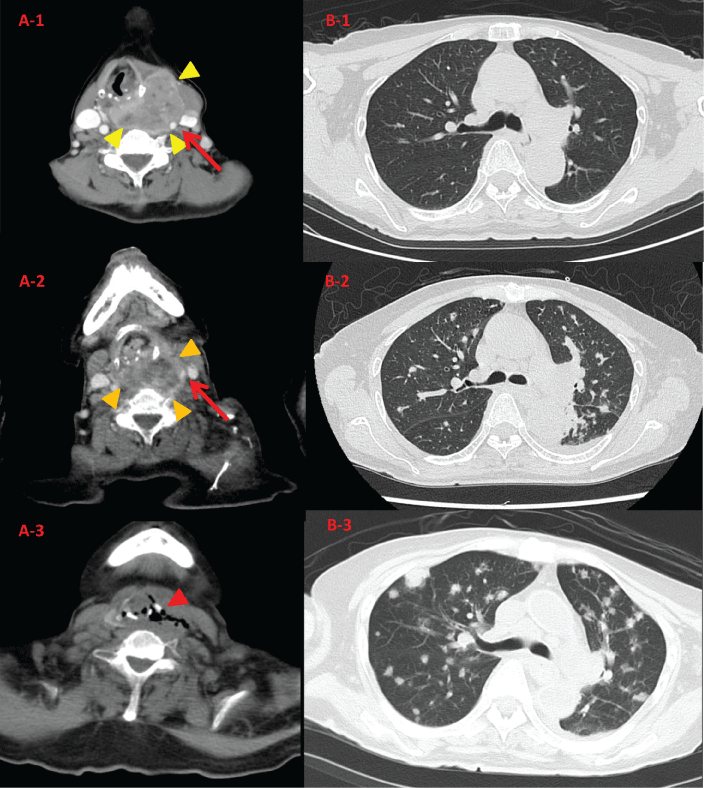International Journal of Cancer and Clinical Research
Massive Arterial Bleeding after Lenvatinib Therapy for Thyroid Cancer
Koichi Suyama1*, DaizoMurakami2, Saori Fujiwara3, Takashi Takeshita3, Aiko Sueta3, ToukoInao3, Mutsuko Yamamoto-Ibusuki3, Yutaka Yamamoto3, Shin-yaShiraishi4 and Hirotaka Iwase3
1Kumamoto University Hospital Cancer Center, Kumamoto University, Japan
2Department of Otolaryngology-Head Neck Surgery, Kumamoto University, Japan
3Department of Breast & Endocrine Surgery, Kumamoto University, Japan
4Department of Radiology, Kumamoto University, Japan
*Corresponding author:
Koichi Suyama, Kumamoto University Hospital Cancer Center, Graduate School of Life Sciences, Kumamoto University, 1-1-1, Honjyo, Chuo-ku, Kumamoto-city, 860-8556, Kumamoto, Japan, Tel: +81-96-373-5599, E-mail: kou_susan@yahoo.co.jp
Int J Cancer Clin Res, IJCCR-3-074, (Volume 3, Issue 6), Clinical Image; ISSN: 2378-3419
Received: November 10, 2016 | Accepted: November 23, 2016 | Published: November 26, 2016
Citation: Suyama K, Murakami D, Fujiwara S, Takeshita T, Sueta A, et al. (2016) Massive Arterial Bleeding after Lenvatinib Therapy for Thyroid Cancer. Int J Cancer Clin Res 3:074. 10.23937/2378-3419/3/6/1074
Copyright: © 2016 Suyama K, et al. This is an open-access article distributed under the terms of the Creative Commons Attribution License, which permits unrestricted use, distribution, and reproduction in any medium, provided the original author and source are credited.
Although lenvatinib was approved for differentiated thyroid carcinoma (DTC) by the FDA [1], major bleeding has been reported during lenvatinib treatment [2]. Here, we report a case of massive bleeding in a lenvatinib-treated patient with advanced papillary thyroid carcinoma.
Patient
A 69-year-old woman presented with hoarseness and other symptoms of laryngeal stenosis. A palpably large tumorin her neck was shown by computed tomography (CT) to expand invasively from her upper left thyroid lobe, and to involve her left common carotid artery and internal jugular vein (Figure 1 A-1). The diagnosis of papillary thyroid cancer was based on cytological evidence from fine needle aspiration biopsy. This tumor was diagnosed as inoperable, locally advanced papillary thyroid carcinoma. She underwent tracheostomy and gastrostomy, and then regional irradiation up to 60 Gy (2 Gy × 20, boost 2 Gy × 10) for local control. CT scan was performed after completion of radiotherapy and tumor shrinkage was confirmed. Asrapid-growing lung metastases appeared during irradiation, (Figure 1 B-2), she began lenvatinib about 1.5 month after finishing irradiation, at 14 mg/day-dose-reduction level 2, out of concern for bleeding risk. On Day 14 after starting lenvatinib, it was stopped because of grade 2 hypertension & proteinuria. Lenvatinib was restarted at 10 mg/day on Day 22 because her hypertension and proteinuria had improved. However, the patient died of massive arterial bleeding through her tracheostomy orifice on Day 24. Autopsy imaging revealed that the shrinking of the primary lesion left a sizeable air space near her left common carotid artery (Figure 1 A-2 and Figure 1 A-3). The artery ruptured, and apparently caused the bleeding. Prior to administration of lanvatinib, the patient did not have a propensity to bleed such as antiplatelet or anticoagulant therapy. Her lung metastases had also increased (Figure 1 B-1 and Figure 1 B-3).

.
Figure 1: CT images of a 69-year-old woman with inoperable, locally advanced papillary thyroid carcinoma.
A-1) At diagnosis, primary lesion (arrowhead) had invaded surrounding structures, especially the left common carotid artery (arrow); A-2) After radiation. Left common carotid artery was still involved (arrow); A-3) Autopsy imaging. Air bubble (arrowhead) suggests tumor necrosis and shrinkage by lenvatinib; B-1) Lung before irradiation to primary lesion showed nometastases; B-2) Multiple lung metastases appeared after irradiation; B-3) apparently progressed (autopsy imaging).
View Figure 1
Discussion
Although lenvatinib is a promising drug with a high objective response rate (64.8%) against DTC, it also carries a high risk of arterial bleeding-a risk that becomes greater still when the tumor involves a major artery. Massive bleeding has been reported during lenvatinib therapy, especially in anaplastic or poorly differentiated thyroid carcinoma.
This patient underwent irradiation for her primary lesion before receiving lenvatinib therapy, which may have inflamed her arterial tissues and rendered them more fragile and vulnerable to the tumor as it was shrunk by lenvatinib, thus causing the massive bleeding.
Autopsy imaging revealed obvious shrinking of primary tumor-presumably due to the effectiveness of lenvatinib. However, lenvatinib apparently also decreased the vessels’ ability to make repairs, which could affect bleeding. Lenvatinib therapy was started within a month after radiation because of rapidly increasing lung metastases. This timing might have promoting the patient’s massive bleeding, even though we tried to diminish the bleeding risk by using an initial dose that was decreased by 2 steps. The bleeding event also occurred relatively early, at Day 23 from beginning the lenvatinib regimen. The reason of the efficacy divergence between primary and metastatic lesion is not clear, but similar situation is occasionally happened during cancer therapy.
The points which we must learn from this episode are:
(a) Lenvatinib administration must be cautiously administered, and its timing should be considered carefully for patients who undergo irradiation; and
(b) Strict assessment of tumor invasion to surrounding vessels must be performed before administering lenvatinib.
Accumulating cases will help form the criteria that permits afe lenvatinib administration. At the moment, if there is no risk (ex. prior radiotherapy, skin invasion of primary tumor, fistula of tumor, etc) for lenvatinib administration, we will take into consideration of using lenvatinib for such locally advanced thyroid cancer patients.
References
-
Schlumberger M, Tahara M, Wirth LJ, Robinson B, Brose MS, et al. (2015) Lenvatinib versus placebo in radioiodine-refractory thyroid cancer. N Engl J Med 372: 621-630.
-
Maria E Cabanillas, Martin Schlumberger, Barbara Jarzab, Renato G Martins, Furio Pacini, et al. (2015) Phase 2 trial of lenvatinib (E7080) in advanced, progressive, radioiodine-refractory, differentiated thyroid cancer: A clinical outcomes and biomarker assessment. Cancer 121: 2749-2756.





